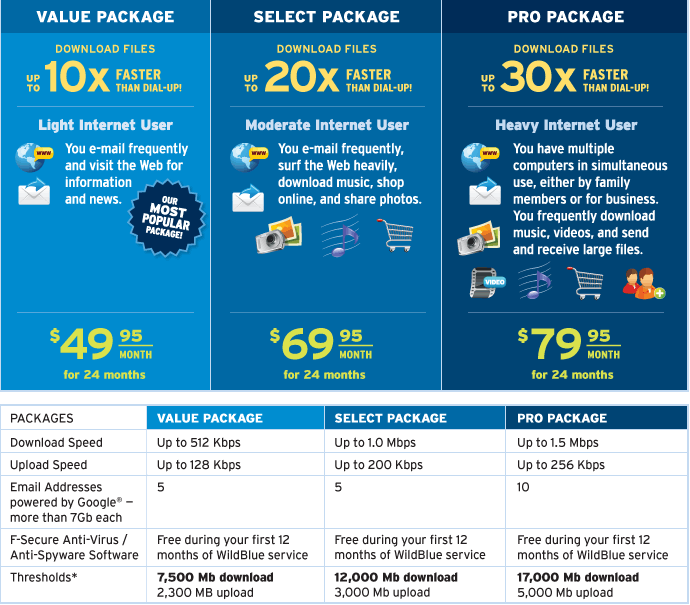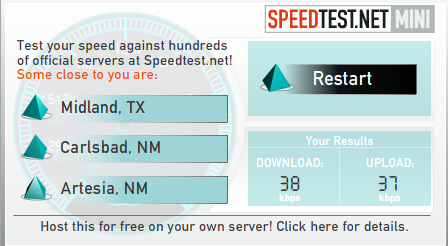image courtesy of toothpaste for dinner
Cloud computing. It is here. It is powerful. It is growing. It is a good thing? Had you asked me a week ago my answer would have been a resounding “Yes!” A week later, I’m not sure sure.
Read on if you care to join me in my wireless nightmare …
For many years, Dial-Up was the only way most people could get online reliably, and the two main sources of internet access seemed to be AOL and to a lesser degree, MSN; because I wanted to be different, I went with MSN, and I thought it was great because Dial-Up was all I knew.
By the early 2000s, DSL service from Verizon was widely available, and within a few years Broadband Cable Internet was too. Both were affordable, and to the best of my knowledge neither was capped at any particular usage point — and if they were, I never managed to hit the cap. Needless to say, a speedy and unlimited in-home broadband connection quickly became something that I — and I daresay millions of others — completely took for granted.
Fast forward to 2008, when I moved to Kevin’s ranch outside of Eldorado, Texas, and my options became much more limited. DSL and Cable were not available outside of the town limits, but dial-up was available on his Verizon home line. The good news was that he had “broadband internet access” through West Central Wireless, which was basically a beamed microwave signal from a tower. This only worked a his house because he had an antenna with an unobstructed view of the transmitting tower. I put it in quotes because it wasn’t anywhere near as fast as what I was used to, but it was still unmetered (at least, as far as I could tell), and it got the job done.
This solution worked well enough, even if speeds were not quite what I was used to.
Then came the next move and… “worked well enough” became “lucky to have any connection at all”.
In 2009, I like to joke that Kevin and I became modern pioneers. We picked a completely wild and unimproved location, and we drilled for water. Once we’d found out that water was available, we installed a well, figured out where a septic could most economically be placed, and had a stock tank put in that would serve double-duty by watering the livestock and providing us with a place to swim. We had an electric line installed, a house was built, decks and patios were installed, and a yard was put in; we made a home.
Noticeably absent were two things that most homes in the city have pre-installed — we didn’t have a single telephone jack, nor were we wired for cable. Instead, we relied on our mobile phones for communication and DirecTV Satellite for television service.
Internet access suddenly became a HUGE deal.
We had hoped that we could continue Internet service with West Central Net in our new location, but alas — our home did not have an unobstructed view of the WCN tower. We were told that West Central was in the process of upgrading their equipment, and that a solution which wouldn’t need a direct line of sight would soon be available, but “soon” was still months away. That left only one option: Satellite Internet.
I researched Satellite Internet providers, and ended up with two candidates, Starband (which I had previously tried and was thoroughly unimpressed with), and DirecTV (formerly Hughes) which was served through WildBlue. Installation and monthly costs were certainly reasonable; in 2009 Wild Blue started at $39.99 per month, with the highest package at $69.99; we were charged $200 or so for the installer to come out and put everything in, which was fine with us! We knew that our installation was definitely not “standard”.
I’ll admit to being a bit concerned though, because the three WildBlue package costs were not only separated due to WildBlue offering faster connection and download speeds on each progressively higher level, they were tiered according to the amount of data we would be allowed to download and upload per 30 day period, due to WildBlue’s “Fair Access” Policy (FAP).
Fair access? That was a new concept for me.
Here’s the thing; by this point Gear Diary was just over two years old. As a result I was extremely reliant on my Internet connection. It wasn’t just a convenience, it was a necessity for the site to continue thriving.
Moreover, I had increasingly embraced cloud computing, and I took unmetered broadband Internet access for granted. I don’t think that I had ever really stopped to consider exactly how much data I used when uploading photos, uploading or downloading YouTube videos, running online backup products like SugarSync or DropBox, downloading music and Apple iTunes updates or when doing anything else I did online, but I figured it couldn’t be that bad.
The main thing was that I didn’t want to nickel and dime myself on data access, because I need a solid and fast broadband connection to operate Gear Diary effectively! So just to be safe, I opted for the highest data package at $69.99 per month, agreed to the two-year service commitment, and considered this one more hurdle jumped. Whew!
I don’t remember what the exact upload and download amounts offered in March 2009 happened to be, but here are the prices and amounts for the packages WildBlue offers now. I’m sure what we had was pretty similar:

All was good right? WRONG! We were throttled within the first week.
Seriously, we opted for the top-tier package and we still throttled the first week. Here’s the weird thing — we were out of town for much of that first week, and there was absolutely no way that anyone could had been piggybacking off of our secure network, but WildBlue said we had hit our allotted threshold.
As a result, we were choked down like a misbehavin’ dog on a chain.
We had fallen under WildBlue’s Fair Use Policy (FAP), and apparently this was (and is) pretty common because the WildBlue forums are completely loaded with other people’s complaints.
Here’s the gist of the policy:
WildBlue gives the customer a specific number of Gigabytes that can be downloaded and uploaded in any given rolling 30 day period. For example, the Pro-Pak user is given a 17Gig, or 17,000MB download limit and a 5Gig, or 5,000MB upload limit. Should the customer exceed this limit they will be fapped. They will be throttled down to much slower speeds until they reach 70% of their rolling 30 day limit. A monthly limit was used for several months however some users would see that they had perhaps 8Gig of download bandwidth that they had not used on the 29th day. The user would then download everything and anything in order to get their monies worth and all use all of their allotted bandwidth. This created overuse of the system and causing slowdowns near the end of each month. By using a rolling Fap, if you use a large amount of your bandwidth on a given day and go over the limit set by your plan, you would have to wait until that day rolled out of the rolling 30 days. This has effectively stopped this type of use. Fap was designed to help all users to a equal amount of internet access.
Let’s face it, not only did I not WANT to ever go through the inconvenience of being unable to access my email, the site, my RSS feeds or any other online thing again, but I couldn’t afford to run into this issue again. I had to do something.
It turns out WildBlue has business account options, and I was relieved when they “allowed” me to convert my two-year $69.99 per month contract with WildBlue into a two-year contract with their business account reseller, Dove Digital.
Once again I opted for the highest plan offered; this one allotted 30 GB download and 10 GB upload for $199.99 per month. I sucked it up, called this a cost of doing business, and I considered myself good to go. Because honestly, at this point — what other choice did I have?
Problem solved right? Wrong, we were just getting started.
First off, I had to deal with latency issues and poor upload speeds which meant issues with using Skype, VOIP, online gaming, and even uploading photos for reviews, but hey! I rationalized that this was the price of living where I wanted, and I could deal with the trade! I also had to suffer through outages nearly every time the weather was poor, but I rationalized that I live in West Central Texas, so the skies are usually clear. And if it rained it was a small price to pay, because we always need rain! And then … I also had to accept the fact that uploading videos and video unboxings was going to be a thing of the past, but again I rationalized that the comments left about me on our YouTube channel each time I did a video were getting old anyway! And yes, each time I had to download another 600MB+ Apple update for my iPad, iPhone or iTunes, I wondered in the back of my mind if they might somehow one day add up and bite me on the butt, but hey — nothing had happened yet, so I figured that everything was A-OKAY!
Until it wasn’t. And when it went bad, it went bad in a huge way.
All of which brings us to last Thursday evening.
It started innocently enough. I noticed that the internet was more sluggish than usual. Looking at a stack of product reviews that couldn’t wait and items that needed to be edited, I continued to plug on.
Then the internet ground to a halt and I had to call it a night.
I told the team that things were even worse than usual, but that I fully expected things to be back to their mediocre normalness in the morning.
Morning came and things weren’t moving any more quickly.
Friday I called Dove Digital … and I was told that we had been FAP’d — throttled and choked! This was despite being on the highest plan they offered, and yet we had still managed to exceed the data threshold. Urgh!
I was told to wait until Sunday night before I tried to do anything online again, and I should be okay.
I managed to get through the weekend by using my iPad 3G to answer email and do light editing.
Sunday night, we were still choked.
What in the world could have possibly caused us to exceed our thresholds? According to WildBlue:
Some activities are more likely to exceed the upload and/or download usage thresholds and cause speeds to be slowed under the Fair Access Policy. Several examples are listed below:
- Full-length movie downloads
- Unsecured wireless router
- Heavy use of peer-to-peer (P2P) file sharing programs
- Continuous downloading or viewing streaming media content such as; online video and radio
- Extended use of web cameras
- Extensive downloading of large applications or files
- Extensive uploading of home movies, photos, and/or large email attachments
- Extensive use of online backup services such as Carbonite, Mozy, SOS and HP Upline.
Okay fine … I get it. One of the side effects of embracing cloud computing is that I do many of the things toward the bottom of the list, and evidently they added up until I was FAP’d by my Internet service provider.
How long would I really have to wait until I had decent internet speeds again? WildBlue doesn’t do their 30 day usage period by the calendar, so it wasn’t just a matter of waiting for my next billing date. Instead they use what’s called a “rolling 30 days”, which is explained this way:
Your daily upload and download data usage is measured to determine if your total usage has exceeded either of your usage thresholds over the previous 30 days for the service plan that you have selected.
A rolling 30 days is defined as “the past 30 days” from the current date.
For example, if today were July 25, 2008, your usage would be measured from July 25, 2008 back to June 26, 2008. If you check your usage again on the next day, July 26th, your 30-day window would be from July 26 back to June 27.
Note: The rolling 30 days is independent of the number of days in the month.
Since the WildBlue site I was given to monitor my bandwidth has been conveniently down ever since I was throttled I can’t even check and see where my usage level sits … but as of today, we are still choked.

what choked looks like on WildBlue
Now I’ll admit that for half a moment while I was talking to my Dove Digital rep, I seriously considered asking if perhaps they had added a newer higher priced business plan than the one I am already on, in which case I would just bump my service level up another notch.But then I stopped myself. I am now out of my two-year contract period, and half the time I am dissatisfied with WildBlue’s service because it performs so much more poorly than advertised.
Did I really want to throw any more of my money at a bad solution.
Not really.
The obvious solution would be to try to limp along while the FAP period with my MiFi, but no mobile carrier offers 3G where my home sits. Instead I have been using my iPad2 3G on non-3G speeds to check email and do light editing. And I am still waiting for the choke-hold to be loosened.
As a side note: I put in a call to West Central Net to see if they ever finished that upgrade they were talking about two years ago, the one that would make it possible to get service even without a direct view of the tower. They are coming out on Thursday morning to do the test, and I am half-afraid to dare hope that for their $59.99 Platinum plan I could finally kick WildBlue to the curb.
In the meantime, I am left nearly disconnected and fuming … and wondering if perhaps it is unrealistic for me to try to keep so much in the cloud. I also can’t help but wonder this isn’t the type of thing that will eventually be the cloud’s downfall.
I’m NOT a data hog. I don’t move gigabytes of data back and forth from cloud storage, and I rarely use streaming music services; I don’t download games, and I know better than to even try to stream movies … I don’t have a Netflix subscription. I understand that all of the streaming services people on unmetered broadband enjoy and yes — largely take for granted — are not options for people in my situation, and I know that I may not ever be able to do many of the things that are taken for granted as part of computing in 2011. I get that there is a trade-off, and I am willing to accept it, because it does allow me to live exactly where I want to be. And yet, it seems unbelievable that in 2011 people who live in rural areas should be so cut off.
The cloud is powerful; it is so, so 2011, but with Internet providers still living in the 1990s, I can’t help but wonder… are ISPs about to rain on the cloud’s parade?
Because all of you people who live in urban areas with seemingly unmetered broadband, what’s happened to me could eventually apply to you as well! We have already seen “unlimited” data on many of mobile plans get capped with metered amounts, and now internet service providers in Canada and the US are doing or at least considering the same.
So how about you? Have you dealt with metered internet at home or at work? Do you have reservations about the cloud, knowing that if everything is stored there, putting it there and accessing it may not always be an affordable option? Or are you tripping along as I was, thinking that because you are paying XX amount of dollars and you don’t use that much data, you’ll be just fine? Do tell!
